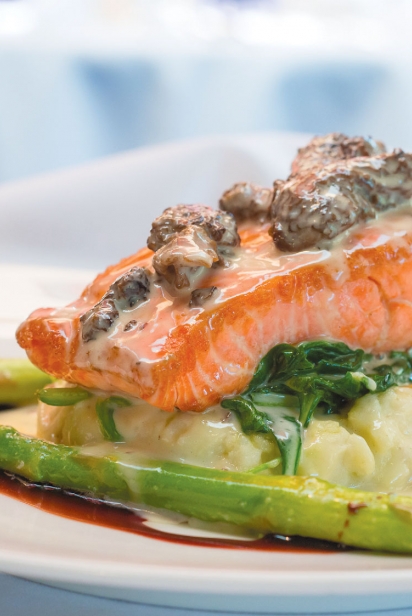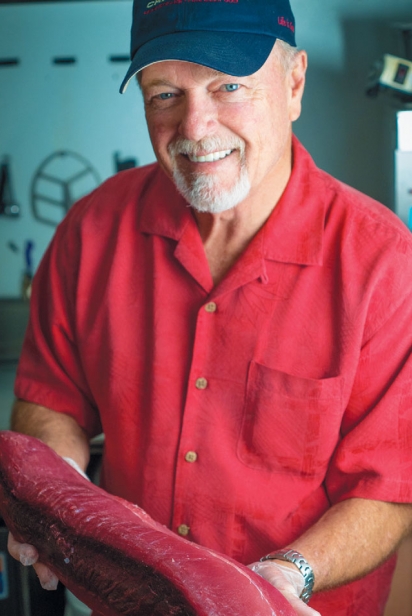Fresh Catch: Chandlers Hooks High-End Seafood from Hawaii and Alaska
With a delicate swipe, Chef Luis Flores slid his slender 10-inch fillet knife under the grey skin of a massive slab of fresh tuna. The fish skin fell off like a pearly wrapper, leaving a stunning ruby-hued hunk of sushi-grade ahi on the cutting board.
“This knife has been my friend for the last 10 years,” said Flores, who moved to Boise from California a decade ago to become the executive chef at Chandlers Steakhouse.
The 17-pound ahi, a name that refers to both the bigeye and yellowfin tuna species, had been flown in the night before from the Honolulu Fish Auction in Hawaii.
“I look for the most bright-red piece of fish,” said Flores, who works with a direct contact at the Honolulu auction. “See how dark cherry it is? That’s what I’m looking for; that’s a beautiful, perfect color for us. I don’t think anyone in Idaho brings in this quality.”
Ahi is graded according to quality, with the highest grade being No. 1+ and the lowest being No. 4. Chandlers only sources No. 1+, which the Joint Institute for Marine and Atmospheric Research defines as “large, fresh firm fish with muscle that is bright red, highly translucent and has high visible fat content.”
Chandlers goes through around 60–70 pounds of Hawaiian ahi a week, which it serves in appetizers like the Tower of Tuna—a cylinder of diced ahi and Hamachi cubes layered with chopped avocado and tomato—and the seared Black Orchid tuna with cabbage and mustard sauce. Chandlers also offers an ahi entrée, which is pan-seared rare, sliced and served with wasabi mashed potatoes in a sake, soy and ginger sauce.
Even though Chandlers might look like an old-school steak house at first blush—with its low-lit leather booths, extensive wine list and live jazz—Chef Flores says seafood accounts for a surprising percentage of the restaurant’s overall sales.
“If I were to show you my numbers, it’s probably 50/50,” said Flores. “We are a steakhouse and everything, but our seafood is right there, too.”
And ahi isn’t the only fresh catch on the menu at Chandlers. Resting on the stainless steel table next to the crimson slab of ahi was a head-on, troll-caught king salmon from Alaska packed in crushed ice. Flores will break down the whole 26.5 pound fish and portion it up for one of the restaurant’s classic entrées: pan-seared king salmon on garlic mashed potatoes with roasted shallots and wild mushrooms in a Pinot Noir sauce. Other fish options at Chandlers include swordfish and mahi mahi, both shipped in from Hawaii, and halibut delivered from Alaska.
“This piece came out of an 80-pound fish; it’s pretty huge,” said Flores, hoisting up a cloudy-white halibut loin with both hands. “And it’s probably only one-quarter of the fish.”
Chandlers General Manager David Boyle says each kind of fish served at Chandlers has a distinct preparation designed to complement its unique flavor and texture.
“With the halibut, it’s a delicate beurre blanc–style sauce with dill and caper because you don’t want to overpower that,” said Boyle. “With the salmon it’s a pretty classic, almost French, Pinot Noir reduction. … The mahi mahi has macadamia nut, ginger, lemongrass, coconut—kind of a Thai-style. And the swordfish is more of a Mediterranean-style with capers, peppers and olives.”
Aside from fresh fish and shellfish—like Alaskan king crab legs, Kumamoto oysters, Mexican prawns and Maine lobster tails—Chandlers also sources authentic Wagyu beef from Japan.
“This is actually real Wagyu,” said Flores, opening a walk-in refrigerator and gesturing to a vacuum-sealed hunk of exquisitely marbled meat. “This is a whole tenderloin. It comes with a certificate, believe it or not. I joke with my crew in here, ‘This piece of meat has more information than we have.’ There’s a nose print—it’s got everything, like a baby.”
Flores says one tiny piece of Wagyu steak costs the restaurant $65 wholesale and they sell it for $120. The cylindrical tenderloin costs $1,000 wholesale. But Flores says Boiseans don’t seem to have problem paying top dollar for these top-notch products—whether it’s fresh fish flown in from Hawaii or authentic Wagyu beef from Japan.
“When we first brought it in, I thought we weren’t going to do very well with it because it’s so expensive. … But people have no problem paying. I haven’t heard anyone complain about the price on that one,” said Flores. “That’s what makes me think that Boise is just as big as any city.”
Tara Morgan is a freelance food and booze writer. She's the Boise Weekly's roving food writer, an Editor at Edible Idaho and runs the website Boise Feed.








